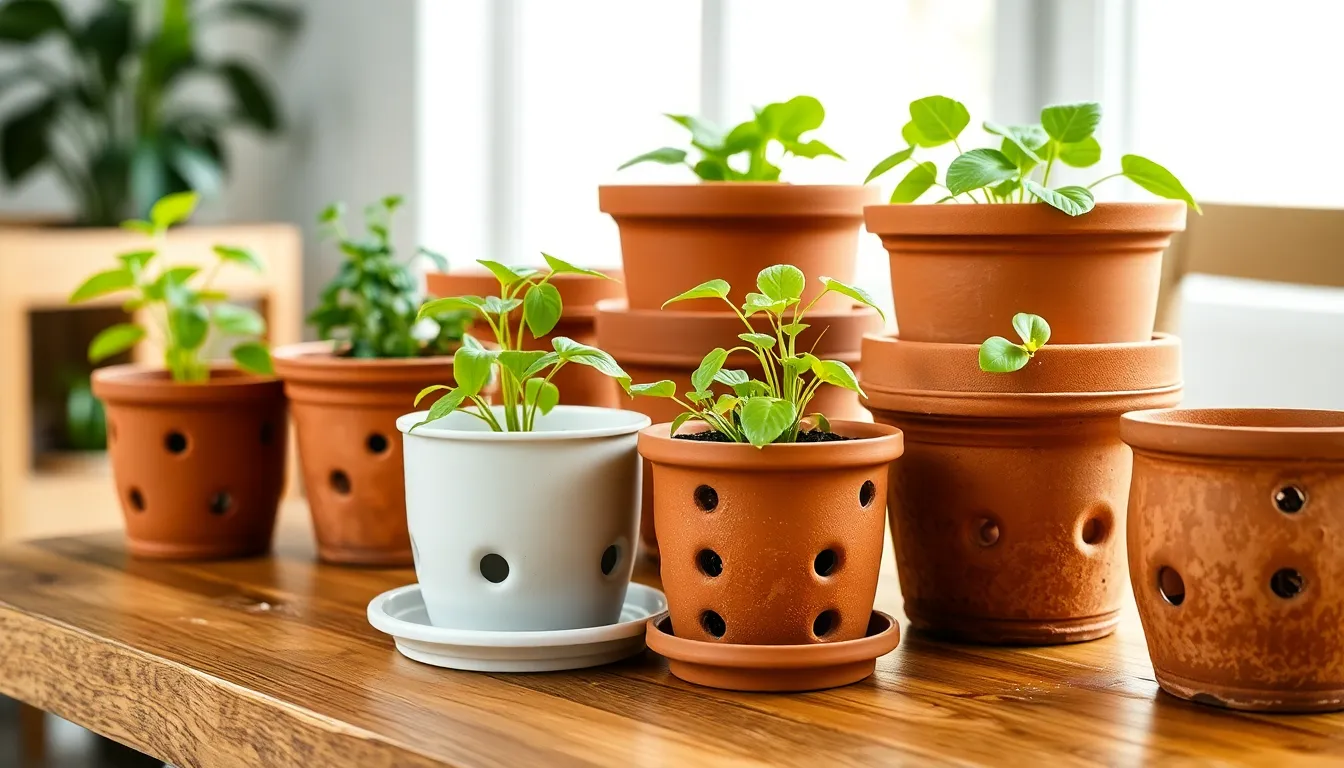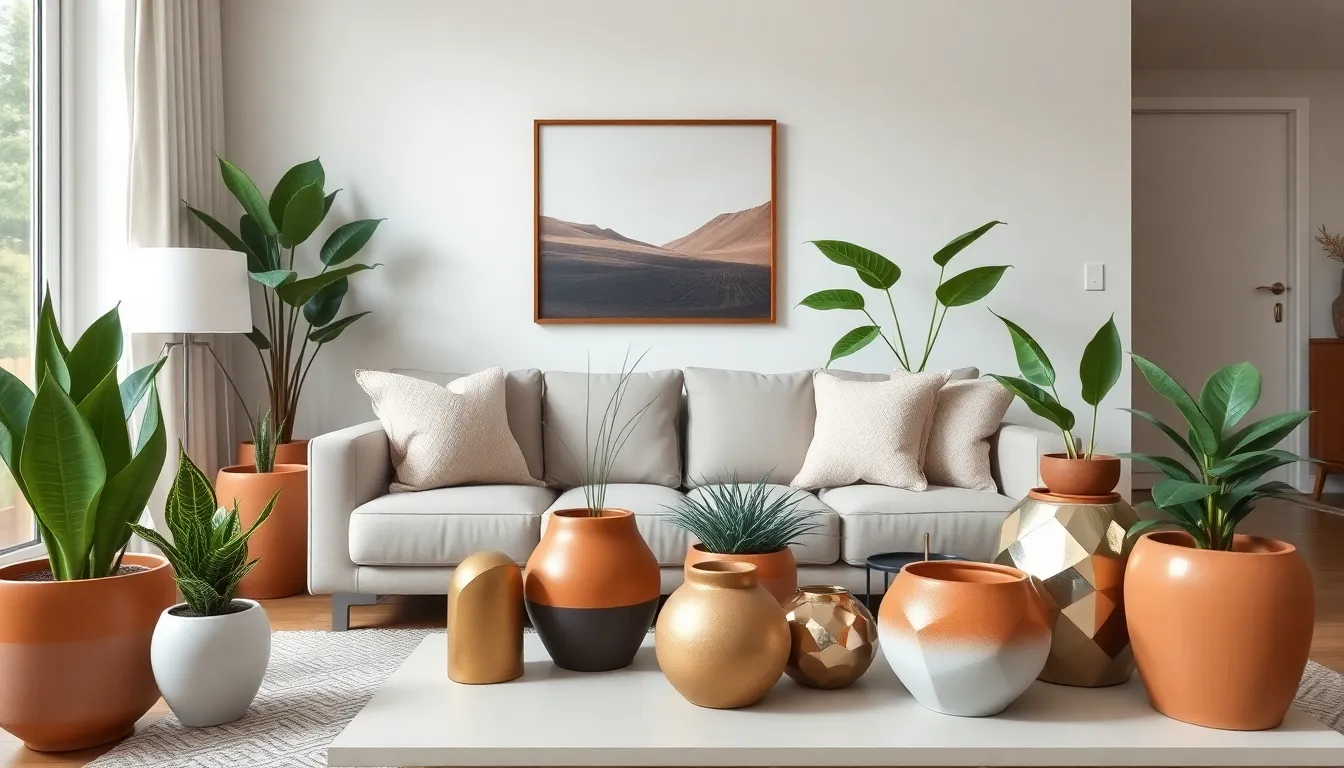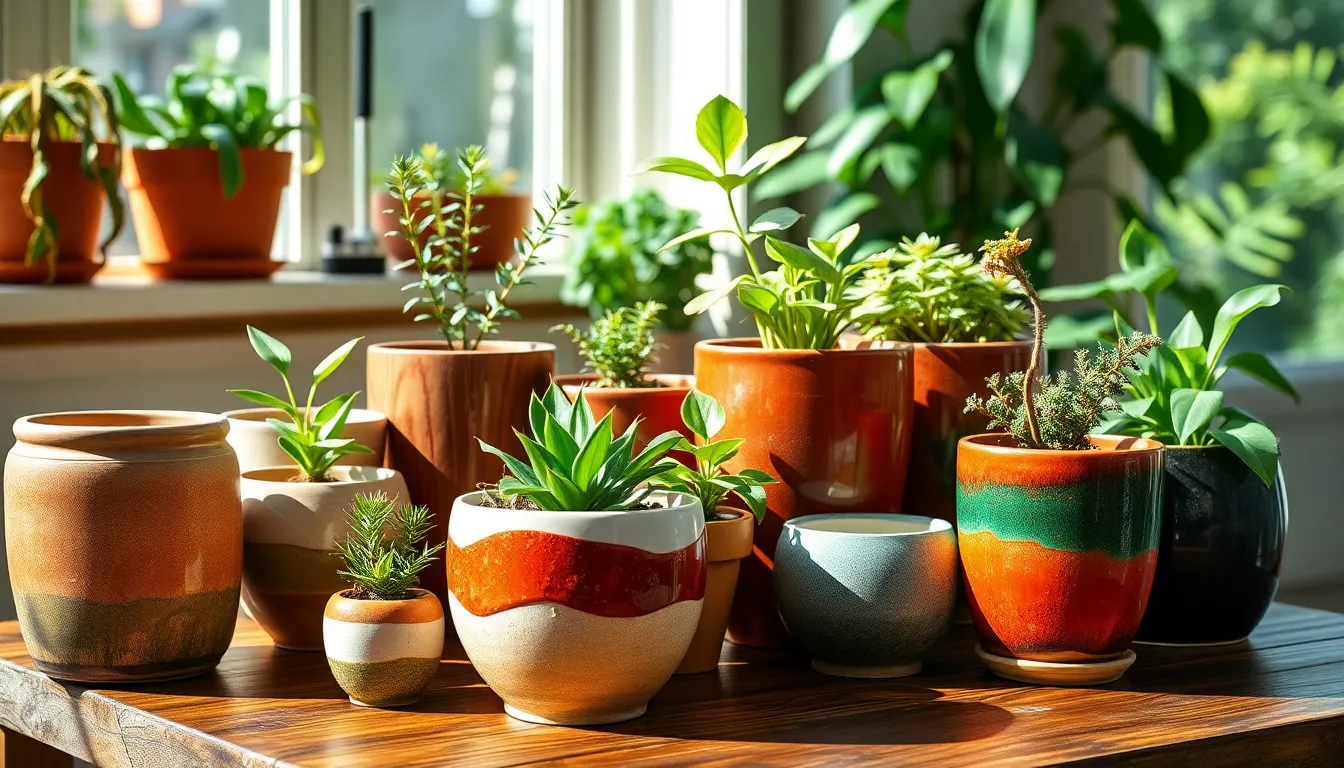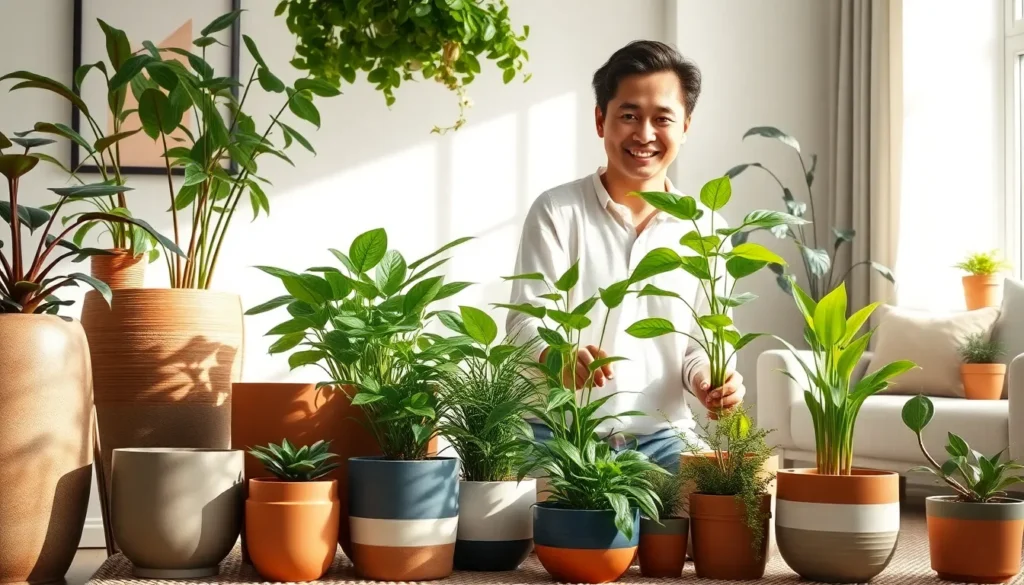Indoor plants have become the cornerstone of modern home design and we’ve all witnessed their incredible ability to transform any space into a vibrant living environment. But here’s the thing – your plant’s potential is only as good as the pot it calls home.
We’ve discovered that choosing the right pot isn’t just about aesthetics. It’s about creating the perfect foundation for your green companions to thrive. The wrong container can lead to root rot overwatering issues or stunted growth while the perfect pot becomes an investment in your plant’s long-term health and your home’s beauty.
Whether you’re a seasoned plant parent or just starting your indoor jungle journey we’re here to guide you through everything you need to know about selecting the ideal pots for your indoor plants. From drainage essentials to size considerations we’ll help you make choices that keep both you and your plants happy.
Choose the Right Size Pot for Your Indoor Plants
Selecting the proper pot size directly impacts how well your indoor plants thrive and develop their root systems. We’ll explore the key factors that determine the ideal container dimensions for optimal plant health.
Consider Root System Growth Patterns
Understanding your plant’s root development helps us determine the appropriate container width and depth. Shallow rooted plants like succulents and herbs need wider containers rather than deep ones, while taproot plants such as peace lilies and rubber trees require deeper pots to accommodate their downward growing roots.
Fibrous root systems found in ferns and spider plants spread horizontally, so we recommend containers that provide adequate width for lateral expansion. Root bound plants show signs like roots circling the pot’s bottom or growing through drainage holes, indicating it’s time to upsize by 1-2 inches in diameter.
Fast growing plants like pothos and philodendrons develop extensive root networks quickly, requiring containers with room for expansion. We suggest choosing pots that allow 1-2 inches of space around the current root ball to prevent overcrowding.
Account for Plant Maturity Size
Mature plant dimensions guide our pot selection to ensure long term growing success. Small houseplants like air plants and baby tears remain compact, needing 4-6 inch containers even at full size, while large specimens such as fiddle leaf figs and monstera deliciosa require 12-16 inch pots when fully grown.
Medium sized plants including snake plants and ZZ plants typically need 8-10 inch containers at maturity. We recommend researching your exact plant variety’s adult size before purchasing containers to avoid frequent repotting.
Growth rate affects our sizing decisions since slow growing plants like cacti can remain in the same pot for years, while rapid growers need larger containers sooner. Consider your plant’s ultimate spread and height when selecting initial pot dimensions.
Balance Pot Proportion with Plant Height
Visual proportion creates an aesthetically pleasing display while supporting plant stability. We follow the general rule that pot height should equal approximately one third of the total plant height, ensuring the container complements rather than overwhelms the foliage.
Tall plants like snake plants and dracaenas need wider, heavier pots to prevent tipping, especially containers with a diameter at least half the plant’s height. Top heavy plants require stable bases to maintain balance and prevent accidents in high traffic areas.
Short bushy plants look best in proportionally sized containers that don’t dwarf the foliage. We recommend measuring your plant’s height and selecting pots that maintain proper visual balance while providing adequate growing space for healthy development.
Select Proper Drainage Features for Healthy Plants

Proper drainage forms the foundation of successful indoor gardening. We’ll explore the essential features that keep your plants healthy and thriving.
Identify Essential Drainage Hole Requirements
Drainage holes at the bottom of indoor pots allow excess water to escape, preventing soggy potting media that can cause root rot and fungal infections. This drainage mimics natural soil conditions where water is pulled away from roots.
The number of drainage holes depends on pot size – a 36-inch planter benefits from 3-4 holes, while a 46-inch one needs 4-6 holes to ensure adequate water flow. Holes must be sufficient in size and quantity to allow excess water to drain out freely.
Proper drainage enables thorough watering practices, such as watering until it drains from the bottom, which ensures the entire root ball is adequately saturated without becoming waterlogged. Pots without holes (often called sleeves) are typically meant to hold a plant in its original nursery pot rather than to pot directly into, as they trap water inside and increase the risk of root rot.
Understand Saucer and Tray Benefits
Saucers and trays placed under pots catch excess water draining through the holes, preventing mess and protecting surfaces while allowing water to drain away from roots effectively. These accessories provide a practical solution for indoor gardening maintenance.
They help us monitor how much water has drained and prevent stagnant water from sitting directly under the pot’s base when emptied regularly. This monitoring system allows for better watering decisions and prevents overwatering issues.
Avoid Common Waterlogging Issues
Waterlogging occurs when water accumulates in pots without drainage, causing roots to remain wet and suffocate, leading to rot and plant death. This condition creates an oxygen-poor environment that’s detrimental to root health.
Using pots with drainage holes combined with well-draining potting mix and a drainage layer (such as hydrogranules or pebbles) helps maintain air circulation around roots and prevents water from pooling. This layered approach creates optimal growing conditions for indoor plants.
For pots without holes, plants should be watered very carefully or periodically removed to rinse and drain to avoid excess moisture buildup. But, we recommend choosing pots with proper drainage holes to eliminate these complications entirely.
Explore Different Material Options for Indoor Plant Pots

Selecting the right material for your indoor plant pots significantly affects both plant health and home aesthetics. Different materials offer unique benefits that cater to exact plant needs and design preferences.
Compare Ceramic and Terra Cotta Benefits
Ceramic pots excel at moisture retention due to their glazed, waterproof surface, making them ideal for tropical plants that thrive in consistently moist soil. Weight becomes their advantage when supporting top-heavy plants, providing stability that prevents tipping. Temperature fluctuations have minimal impact on ceramic containers, protecting delicate root systems from sudden changes. Diverse shapes and colors allow ceramic pots to complement any interior design style.
Terra cotta pots feature porous, unglazed clay that promotes excellent airflow to plant roots, preventing waterlogged conditions that damage sensitive plants. Moisture evaporates naturally through the clay walls, creating ideal conditions for succulents and plants requiring well-draining soil. Affordability makes terra cotta accessible for budget-conscious gardeners, while their warm reddish-brown appearance adds natural charm to any space.
| Material | Best Plant Types | Key Advantage | Price Range |
|---|---|---|---|
| Ceramic | Tropical plants, moisture-loving varieties | Superior moisture retention | Higher cost |
| Terra Cotta | Succulents, drought-tolerant plants | Excellent root aeration | Budget-friendly |
Evaluate Plastic and Resin Durability
Plastic and resin planters offer lightweight portability that makes rearranging your indoor garden effortless. Resistance to cracking and breakage surpasses ceramic and terra cotta options, though prolonged UV exposure can cause degradation over time. Waterproof properties prevent moisture loss, which benefits plants requiring consistent soil moisture levels.
Breathability limitations in plastic containers can sometimes lead to overwatering issues, requiring careful attention to watering schedules. Cost effectiveness makes plastic pots attractive for large plant collections or temporary growing situations. Color and shape variety allows customization to match existing decor without important investment.
Consider Metal and Fiberglass Alternatives
Metal planters provide exceptional durability and weather resistance, making them suitable for plants that may eventually transition outdoors. Modern aesthetic appeal complements contemporary interior design schemes. Poor insulation properties mean soil temperatures fluctuate more readily, potentially affecting sensitive root systems. Weight falls between lightweight plastic and heavy ceramic options, offering manageable handling with enhanced stability.
Fiberglass pots combine lightweight construction with high durability, creating an ideal balance for frequent plant repositioning. Customizable colors and shapes provide design flexibility that rivals ceramic options without the associated weight. Repaintability allows pot aesthetics to evolve with changing decor preferences. Crack resistance exceeds terra cotta performance, ensuring long-term investment value.
Moderate moisture retention and insulation properties make fiberglass suitable for various plant types and indoor environments. Brittleness concerns that plague terra cotta don’t affect fiberglass construction, reducing replacement costs over time.
Match Pot Styles to Your Home Decor Theme

Creating a cohesive look throughout your living space requires matching pot styles to your existing interior design theme. We’ll explore how to select containers that seamlessly integrate with your home’s aesthetic while showcasing your plants beautifully.
Coordinate Colors with Interior Design
Neutral colors like white, beige, and gray create sophisticated backdrops that make your plants the star of the show. These versatile shades work exceptionally well with minimalist, natural, or industrial design styles while offering a clean, timeless appearance.
Bold color choices can transform your space when used strategically. Blues and greens introduce tranquility and harmony to rooms, while metallic finishes in gold, silver, or copper add luxury and visual contrast that catches the eye.
Monochromatic color schemes provide subtle elegance by using varying shades of the same hue throughout your plant display. Complementary colors from opposite sides of the color wheel create ever-changing contrasts that energize your space, and accent colors can highlight exact areas or plants you want to showcase.
Color coordination extends beyond single pots to your entire plant collection. We recommend selecting a palette of 2-3 coordinating colors that appear throughout your room to maintain visual harmony while allowing for creative expression.
Select Textures That Complement Room Aesthetics
Smooth ceramic surfaces and glossy finishes enhance modern interiors by reflecting light and creating clean lines that complement contemporary furniture. These polished textures work particularly well in spaces with sleek surfaces and geometric elements.
Rustic textures like terracotta, woven fibers, and handcrafted finishes suit bohemian or farmhouse themes perfectly. Natural materials add warmth and personality to spaces, creating an inviting atmosphere that feels lived in and comfortable.
Mixing different textures creates visual interest and depth in your plant displays. Pairing smooth pots with rough baskets or combining matte finishes with glossy surfaces adds a layered, ever-changing look that prevents your arrangement from appearing flat or monotonous.
Marbled and patterned finishes bridge the gap between smooth and textured surfaces. These versatile options work well in transitional spaces where you want to add interest without overwhelming the existing decor.
Choose Shapes That Enhance Space Layout
Tall, slender pots emphasize vertical space and draw the eye upward, making rooms appear larger and more open. Position these containers beside sofas, in corners, or near doorways where they can add height without blocking traffic flow.
Rounded pots create softer lines that feel more inviting and organic in living spaces. These curved shapes work particularly well in cozy areas where you want to soften harsh angles from furniture or architectural elements.
Angular and geometric shapes contribute to modern, structured aesthetics that complement contemporary design. Square, rectangular, and hexagonal pots add visual interest while maintaining the clean lines that define minimalist and industrial styles.
Selecting shapes thoughtfully helps balance your room’s proportions and creates intentional focal points. Large, sculptural pots work best with statement plants like fiddle leaf figs or monstera, while smaller, simpler shapes allow delicate plants to shine without competition from their containers.
Understand Specific Plant Requirements for Pot Selection

Different plant species require exact container features to thrive indoors. We need to match pot characteristics with each plant’s unique water, growth, and root system needs.
Identify Moisture-Loving Plant Needs
Moisture-loving plants thrive when we provide containers that maintain consistent hydration while preventing water stagnation. We should select pots with drainage holes and pair them with trays to catch runoff, creating the perfect moisture balance these plants need.
Materials matter significantly for moisture retention. Ceramic and glazed clay pots excel at holding water longer than porous alternatives, making them ideal choices for plants that enjoy consistent soil moisture.
Water management becomes easier when we use drainage trays beneath our containers. These trays allow us to monitor water levels and ensure excess moisture escapes properly, preventing root rot while maintaining the steady hydration these plants crave.
| Plant Type | Recommended Pot Size | Best Materials |
|---|---|---|
| Small herbs (chives) | 10 inches | Ceramic, glazed clay |
| Lettuce, spinach | 12-16 inches | Ceramic with drainage |
| Larger herbs | 12-16 inches | Glazed containers |
Accommodate Drought-Tolerant Species Preferences
Drought-tolerant plants like succulents and cacti require containers that promote quick soil drying and excellent drainage. Terra cotta and unglazed ceramic pots work perfectly because they naturally wick moisture away from roots, preventing the overwatering that kills these hardy plants.
Size selection proves crucial for these water-wise species. Small containers measuring 4-6 inches suit most small succulents perfectly, allowing their soil to dry quickly between waterings.
Drainage becomes even more critical with drought-tolerant plants since they’re particularly susceptible to root rot. We must ensure our chosen containers have adequate holes at the bottom to eliminate any possibility of standing water around the roots.
Meet Fast-Growing Plant Container Demands
Fast-growing plants demand larger containers to accommodate their rapidly expanding root systems. We need to provide generous space from the start, choosing pots that measure at least 16 inches in diameter for larger shrubs and small fruit plants.
Repotting schedules become more frequent with these vigorous growers. We should plan to repot every 1-2 years or immediately when roots begin emerging from drainage holes, preventing root binding that stunts growth.
Container sizing follows exact guidelines based on current pot dimensions. When our plants occupy containers 10 inches or smaller, we should select new pots 1-2 inches larger in diameter, while plants in larger containers need upgrades of 2-3 inches to support continued expansion.
Growth monitoring helps us stay ahead of our plants’ container needs. Fast-growing species quickly outgrow their homes, requiring us to watch for signs like roots circling the pot’s bottom or emerging from drainage holes.
Consider Budget-Friendly Options for Indoor Plant Pots

Creating a beautiful indoor garden doesn’t require very costly. We can achieve stunning plant displays while maintaining a reasonable budget through smart shopping strategies and creative answers.
Find Quality Affordable Plastic Containers
Plastic pots offer exceptional value for indoor gardeners seeking cost-effective answers. Starting at just $2.49 for smaller sizes, these containers provide durability and functionality that rivals more expensive alternatives. Retailers like Walmart, The Home Depot, and Grow Organic stock extensive selections of affordable plastic pots, many featuring essential drainage holes and matching trays.
Quality makes a important difference when selecting plastic containers. Injection-molded and thermoformed options from suppliers like Greenhouse Megastore deliver superior durability and repeated use capabilities. These containers come in various shapes specifically customized to different plant types, from compact succulents to large statement plants.
Benefits of plastic pots extend beyond their low price point. They’re lightweight for easy repositioning, retain moisture better than ceramic alternatives, and provide excellent growing conditions for indoor environments. Bulk purchasing options can reduce costs further, with tray sets offering multiple containers at discounted rates.
Discover DIY Pot Decoration Ideas
Transforming plain plastic containers into decorative elements adds personality without increasing costs significantly. We can customize inexpensive pots to match any interior aesthetic through simple decoration techniques that require minimal investment.
Painting represents the most versatile decoration approach. Acrylic and spray paints allow us to add vibrant colors, subtle patterns, or artistic designs that complement our home decor. Surface preparation with light sanding ensures better paint adhesion and longer-lasting results.
Fabric wrapping creates textured, sophisticated looks using materials we might already have. Burlap produces rustic charm, while cotton fabrics offer endless pattern possibilities. Securing fabric with strong adhesive or decorative twine completes the transformation effectively.
Stenciling enables precise artistic designs without advanced artistic skills. We can create plant labels, geometric patterns, or nature-inspired motifs using readily available stencils and paint. This technique works particularly well for creating matching sets across multiple containers.
Additional decoration options include applying decorative stones, colorful beads, or decoupage elements for visual interest. These materials can be sourced affordably from create stores or repurposed from existing household items.
Shop Smart for Seasonal Sales and Discounts
Strategic timing maximizes our purchasing power when buying indoor plant containers. Seasonal sales cycles offer substantial savings opportunities that can reduce pot costs by 50% or more.
IKEA’s current promotion through June 2025 exemplifies excellent seasonal savings, with indoor plant pots ranging from $2.99 to $14.99 during their clearance event. Many items carry “last chance to buy” designations, indicating important markdowns on quality containers.
Spring and early summer present optimal buying seasons when gardening activity peaks and retailers compete for market share. Online gardening stores frequently run promotional offers during these periods, particularly on plastic pot collections and bulk purchases.
Newsletter subscriptions from major retailers provide advance notice of upcoming sales and exclusive discount codes. We can monitor multiple suppliers simultaneously to compare prices and identify the best deals available.
End-of-season clearances offer another strategic buying opportunity. Garden centers often discount remaining inventory before transitioning to seasonal merchandise, allowing us to stock up for future planting projects at reduced costs.
Maintain and Care for Your Indoor Plant Pots

Proper maintenance of your indoor plant containers ensures healthy plant growth and extends the life of your investment. Regular care prevents common issues like mineral buildup and disease transmission that can harm your plants.
Clean Different Pot Materials Properly
Different pot materials require exact cleaning approaches to maintain their appearance and functionality. We recommend washing plastic pots with warm soapy water and rinsing thoroughly to remove any residue.
Terracotta pots need special attention because they’re porous and accumulate mineral deposits over time. Soak these containers in a vinegar solution to dissolve buildup, then scrub gently with a soft brush to avoid damaging the surface.
Ceramic pots should be cleaned with mild detergent while avoiding harsh scrubbing that can damage their glazed finish. We suggest using a soft cloth or sponge to preserve the decorative coating.
Metal containers require prompt drying after cleaning to prevent rust formation. Wipe these pots clean with a damp cloth and dry immediately to maintain their appearance and structural integrity.
Prevent Mineral Buildup and Staining
Mineral deposits commonly occur when using hard water for irrigation and create unsightly white stains on pot surfaces. We recommend using filtered or distilled water whenever possible to minimize these deposits.
Existing mineral buildup can be removed by soaking affected pots in diluted vinegar or lemon juice answers. Gentle scrubbing after soaking helps dissolve stubborn deposits without damaging the container material.
Regular exterior wiping prevents staining that can deteriorate pot surfaces over time. This simple maintenance step keeps your containers looking fresh and extends their usable life.
Porous materials like terracotta are particularly susceptible to mineral accumulation and require more frequent cleaning attention than non-porous alternatives.
Replace Worn Containers at Optimal Times
Container replacement becomes necessary when plants outgrow their current pots and develop root binding that restricts healthy growth. We suggest monitoring root development through drainage holes to identify when upsizing is needed.
Cracked or damaged pots compromise both drainage capabilities and structural stability, making replacement essential for plant health. These containers can’t provide the secure environment your plants need to thrive.
Severe mineral buildup or permanent staining that resists cleaning efforts signals it’s time for new containers. When aesthetic or functional issues can’t be resolved through maintenance, replacement ensures optimal growing conditions.
Spring or early summer provides the ideal timing for repotting because plants recover faster during their active growing season. This timing minimizes transplant shock and promotes successful establishment in new containers.
Conclusion
Choosing the perfect pots for your indoor plants doesn’t have to be overwhelming when you understand the fundamentals. We’ve covered everything from drainage essentials and size considerations to material benefits and style coordination that’ll help you create a thriving indoor garden.
Remember that successful indoor gardening starts with matching your pot selection to each plant’s exact needs. Whether you’re working with a tight budget or investing in premium containers your plants will thank you for making informed choices.
The key is finding that sweet spot between functionality and aesthetics. When you combine proper drainage with the right size and materials that complement your home’s style you’ll create an indoor oasis that’s both beautiful and healthy for years to come.
Frequently Asked Questions
What size pot should I choose for my indoor plant?
Choose a pot that’s 1-2 inches larger in diameter than your plant’s current container. Consider your plant’s root system: shallow-rooted plants need wider pots, while taproot plants require deeper containers. For visual balance, the pot height should be about one-third of the total plant height. Always account for your plant’s mature size to avoid frequent repotting.
Why are drainage holes important in plant pots?
Drainage holes prevent water from accumulating at the bottom of pots, which can cause root rot and fungal infections. They allow excess water to escape, ensuring proper root health. Larger pots need multiple holes for adequate drainage. Without proper drainage, roots can suffocate in waterlogged soil, leading to plant death.
What’s the best pot material for indoor plants?
The best material depends on your plant’s needs. Terra cotta pots are excellent for plants requiring good airflow and quick soil drying. Ceramic pots retain moisture well and provide stability. Plastic pots are lightweight and affordable, while metal and fiberglass offer modern aesthetics and durability. Choose based on your plant’s water requirements.
How do I match pot styles with my home decor?
Coordinate pot colors with your interior design using neutral shades for sophistication or bold colors for focal points. Match textures to your room’s aesthetic—smooth surfaces for modern spaces, rustic textures for bohemian themes. Choose shapes that enhance your space layout: tall pots for vertical emphasis, rounded pots for softer lines.
What pots work best for succulents and drought-tolerant plants?
Succulents thrive in terra cotta or unglazed ceramic pots that promote quick soil drying. These materials are porous and allow excess moisture to evaporate, preventing root rot. Ensure pots have drainage holes and use well-draining soil. Avoid glazed ceramic or plastic pots that retain too much moisture for these drought-tolerant plants.
How can I find budget-friendly plant pots?
Shop at retailers like Walmart and The Home Depot for affordable plastic containers. Take advantage of seasonal sales and end-of-season discounts. Consider DIY decoration options like painting, fabric wrapping, or stenciling plain pots. Buy in bulk when possible, and look for clearance items to maximize your budget while creating beautiful plant displays.
How do I properly clean and maintain plant pots?
Clean plastic pots with warm soapy water. Soak terra cotta pots in vinegar to remove mineral buildup, then scrub with a brush. Dry metal containers immediately to prevent rust. Use filtered water to minimize mineral staining. Replace damaged or worn containers during spring or early summer for optimal plant health and successful repotting.
When should I repot my indoor plants?
Repot when you notice roots growing through drainage holes, soil drying out quickly, or stunted plant growth. Spring and early summer are ideal times for repotting as plants are actively growing. Choose a pot 1-2 inches larger in diameter than the current one. Fast-growing plants may need annual repotting, while slow-growing plants can go 2-3 years.







